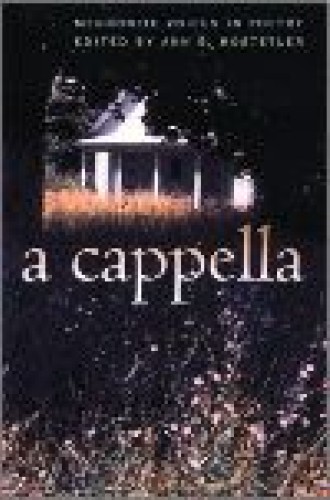A Cappella: Mennonite Voices in Poetry
A Cappella: Mennonite Voices in Poetry.
Edited by Ann Hostetler. University of Iowa Press, 199 pp., $19.95 paperback.
It is hard to imagine the publication of a collection of Lutheran, Presbyterian or Methodist poets. Why, then, a collection of Mennonite poets? Maybe because, proportionately, there seem to be so many of them these days. There are 416,000 Mennonites in North America and 24 poets represented in this collection, of whom 23 are still living. Something has been happening in Mennonite circles that has awakened a particular kind of aesthetic response, and something has been happening in these poets to make them want to represent themselves as “Mennonite.” One would be hard-pressed to find any other group of poets, except maybe Roman Catholics, identifying themselves denominationally.
What makes these poems unique could be the traditional Mennonite connection to the land, although that has not in the past encouraged such an outpouring of poetry. Nature predominates in the poems, whether recalcitrant berry fields in Leonard Neufeldt’s work or the particularities of the tobacco plant in Janet Kauffman’s “Working Tobacco.” But to claim that Mennonite poetry is strong because Mennonites are people of the land is to stereotype their life in a way that many of these poets would resist. In fact, Julia Kasdorf, the best known of the group, grew up near Pittsburgh. Often the connections to the land are through memories only—and sometimes even through the memories of others, which opens the door to feelings of nostalgia and remorse over the loss of something valuable. Betsy Sholl writes in “Redbud”:
. . . Imagine,
standing over a gorge where a waterfall plummets—lost
not so much in thought as its graceful absence, so lost
there is nothing else to want from the world. The world.
How beautiful the word sounds. Whorled. Purple blossoms
on rain-black trees. The enormous eyes of horses. Rock-weed, slate.
The world loving us, who probably have never loved enough,
never dared let ourselves go that far into its beauty.
These poems remind one of Mennonite worship, so spare and clean, the a cappella singing a metaphor for the beauty of simplicity, the four-part harmonies an example of individuals working in community toward a common goal. The community is here in this volume, in which poets talk to each other—Jeff Gundy’s poem with an epigraph from Janet Kauffman, David Wright’s response to Kasdorf’s “Mennonites” in “A New Mennonite Replies to Julia Kasdorf.” We also find the pull of family memory, tragedy and mystery. Jean Janzen (frequently published in the Christian Century) is haunted by the suicide of her Ukrainian grandmother:
The small, abandoned graveyard
lies in tall autumn grass, the markers
tumbled and covered. Last grasshoppers
have gone from the nearby stubbled fields
and a light frost whitens the feathery
heads of foxtail. I have come down
the long narrow road. I have come
with my passport, my photograph
and my name to stand on the unmarked dust
of your body, and there is no sound
but the dry leaves stirring in the alders,
the groaning of roots, and these words
breathing on a page.
The concern for community in this collection is not merely personal or parochial. David Waltner-Toews reflects the Mennonite concern for the global community in several of his poems, most notably and humorously in “A Request from Tante Tina to the Mennonite Women’s Missionary Society to Put Salman Rushdie on the Prayer List” and in “Teilhard de Chardin Surfs the Internet.”
Aware of the pacifist stance of the Mennonite church, one would expect more political statement in these poems, and more emphasis on alternative viewpoints. But for the most part these poets are introspective and find that their poetry calls them, as Richard Wilbur would say, to the things of this world. Jane Rohr’s “The Gearshift Poem,” Julia Kasdorf’s “Eve’s Striptease” and “The Body Remembers,” and any number of other poems reveal a strongly sensual anchoring in the concrete image. Raylene Hinz-Penner’s “Flower” points most directly to the mystery of how art springs from such a plain, almost artless tradition.
I have not missed the irony of this magnetism, my being
drawn to O’Keeffe who posed for hours to display her body
for Stieglitz. In our Kansas home there was no art:
carved wooden plaques or plaster mottoes, As for me
and my house, we will serve the Lord; the orange leaves
of a Robert Wood above the rough tan couch; red plastic
carnations in a ceramic vase on the brown metal stove.
Di Brandt is the one poet who ventures boldly into the areas of peace and justice in a poem on Gaza. She also deals ironically with pacifism in “nonresistance, or love Mennonite style,” a poem about sexual abuse in one Mennonite household. There is no sentimentalizing of some of the tougher aspects of communual life.
This is a collection of well-hewn poems by writers who speak in clear and confident voices. Christian poetry has been dominated by the sacramental traditions. This Anabaptist presence is a new phenomenon worthy of the spotlight Ann Hostetler has thrown on it. With a helpful introduction and afterword (and some of her own fine poems), she has performed a valuable service for these poets and for readers interested in the ways a particular Christian tradition can foster poetry.




